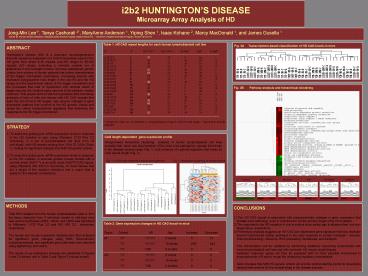i2b2 HUNTINGTONS DISEASE Microarray Array Analysis of HD PowerPoint PPT Presentation
1 / 1
Title: i2b2 HUNTINGTONS DISEASE Microarray Array Analysis of HD
1
i2b2 HUNTINGTONS DISEASEMicroarray Array
Analysis of HD
Jong-Min Lee1, Tanya Cashorali 2, MaryAnne
Anderson 1, Yiping Shen 1, Isaac Kohane 2, Marcy
MacDonald 1, and James Gusella 1 1 Center for
Human Genetic Research, Massachusetts General
Hospital, Boston MA 02114, 2 Children's Hospital
Informatics Program, Boston, MA 02115
Table 1. HD CAG repeat lengths for each human
lymphoblastoid cell line ID
HD CAG 1 HD
CAG 2 Gender Age
Length GUS3227 1 70 19 F na L GUS19217 2 35 17
M 24 S GUS115 3 18 17 M 51 S GUS21273 4 37 22 F
22 S GUS15213 5 41 15 M 35 L GUS4606 6 63 22 M
29 L GUS21250 7 33 17 M 45 S GUS21521 8 36 18 F
15 S GUS13402 9 46 16 M 33 L GUS10438 10 29 17 F
57 S GUS10928 11 20 17 F na S GUS21565 12 38 17
F 38 L GUS301 13 49 20 F 51 S GUS21519 14 24 15
M 9 L GUS13257 15 43 21 M 10 S GUS1729 16 66 21
F 24 L GM7356 17 18 17 M 13 S GUS21145 18 31 17
F 10 S GUS1714 19 52 19 M 31 L F, female M,
male na, not available L, long pathogenic range
S, short normal range Age at time sample
collected
Fig. 3A Transcriptome-based classification of
HD CAG knock-in mice
ABSTRACT Huntingtons disease (HD) is a dominant
neurodegenerative disorder caused by expansion of
a CAG trinucleotide repeat in the HD gene from
about 6-35 repeats (non-HD range) to 36-100
repeats (HD range), extending a normally variable
run of glutamines in the huntingtin protein. We
have established genetic criteria from studies of
human patients that define characteristics of the
trigger mechanism (dominance, increasing severity
with increased polyglutamine tract length in the
non-HD and the HD range) but the biochemical
nature of the trigger mechanism and the processes
that lead to dysfunction and ultimate death of
target neurons, the medium spiny neurons of the
striatum, remain unknown. This project aims to
test the hypothesis that microarray analyses of
sets of cells and tissues with HD CAG repeats
that span the non-HD and HD ranges, may uncover
changes in gene expression patterns that conform
to the HD genetic criteria and reveal the
critical transcriptional regulators that
determine the response to the HD
trigger-mechanism.
Fig. 3B Pathway analysis and hierarchical
clustering
- STRATEGY
- To determine global gene mRNA expression levels
in response to the HD mutation in man, using
Affymetrix U133 Plus 2.0 microarray, in a set of
lymphoblastoid cell lines from 19 individuals,
with HD repeats ranging from 18 to 70 CAGs (Table
1), looking for significant changes that fulfill
HD genetic criteria. - 2) To determine global gene mRNA expression
levels in response to the HD mutation in accurate
genetic mouse models with a juvenile onset
(HdhQ111) or an adult onset (HdhQ50) CAG repeat,
using Affymetrix MG 430 2.0 microarray, for brain
tissues that are a target of the mutation
(striatum) and a region that is spared in the
disease (cerebellum).
CAG length-dependent gene expression
profile Unsupervised hierachical clustering
analysis of human lymphoblastoid cell lines
revealed that there was discrimination of the
short (non-pathogenic) repeats from those in the
disease-causing range (Fig. 1), and evidence of a
genetic signature that varies by CAG repeat
length (Fig. 2)
Fig. 1. CAG-length dependent expression signature
Fig. 2. Hierachical clustering of
variable genes
Immune Mitochondrial
Ribosomal
RNA Transferase
Transport
METHODS Total RNA isolated from the human
lymphoblastoid cells or from the tissue dissected
from 3 individual mutant or wild-type mice was
used to synthesize cDNA / cRNA, and cRNA was
hybridized to Affymetrix U133 Plus 2.0 and MG 430
2.0 microarray, respectively. The human and
mouse expression datasets were then analyzed for
significant gene changes using RMA, Bioconductor,
clustering analysis, and significant gene
pathways were detected using sigPathway and GSEA.
The results of our preliminary analyses are
presented in Figures 1 and 2 (Human) and in Table
2 and Figure 3 (mouse model).
CONCLUSIONS 1) The HD CAG repeat is associated
with presymptomatic changes in gene expression
that predate overt pathology, even in cells that
are not the primary target of the HD mutation.
2) The response to the HD mutation in vivo is
evident at an earlier age in striatum than in a
non-target tissue (cerebellum). 3) Preliminary
analysis suggests an HD CAG size dependent gene
signature that may implicate several fundamental
cellular pathways in the early response to mutant
huntingtin - immune, mitochondria/energy,
ribosome, RNA processing, transferase, and
transport. This interpretation will be
validated by performing additional microarray
experiments with more lymphoblastoid cell lines
and with non-brain HD mouse model
tissues. Validated response genes will then be
assessed both for their potential involvement in
presymptomatic HD and to reveal the underlying
regulatory mechanisms. Gene changes that
fulfill HD genetic criteria will provide optimal
starting points for developing rational
interventions for the earliest steps in the
disease process.
Table 2. Gene expression changes in HD CAG
knock-in mice Tissue Control
HD Age
Increase Decrease ST 7/7 111/111 3
weeks 8 10 7/7 111/111 10 weeks 916 844 7/7 7/
50 5 months 0 0 CB 7/7 111/111 3
weeks 0 0 7/7 111/111 10 weeks 0 0 7/7 7/50 5
months 0 0

